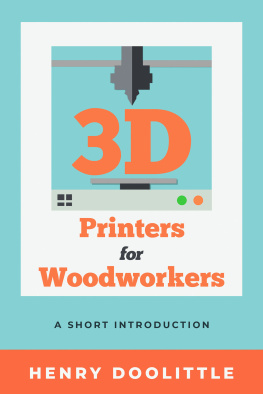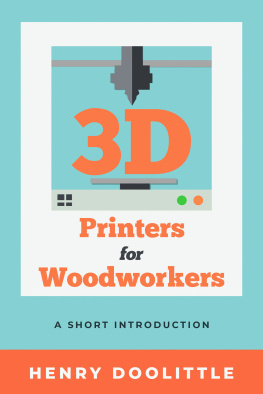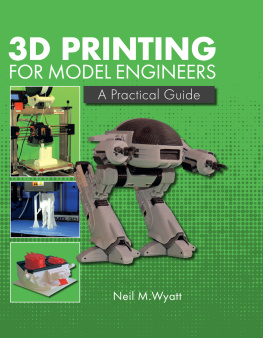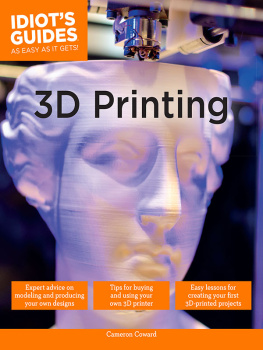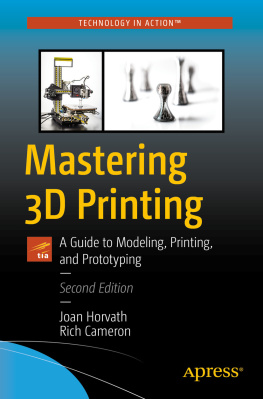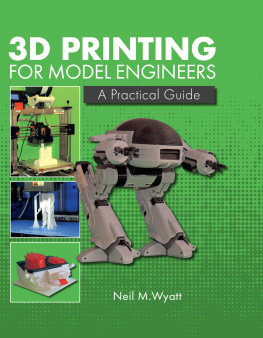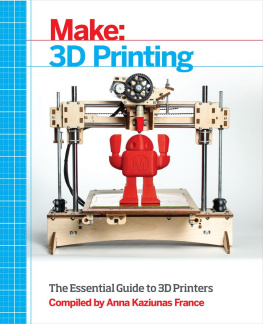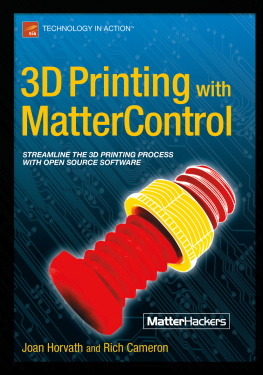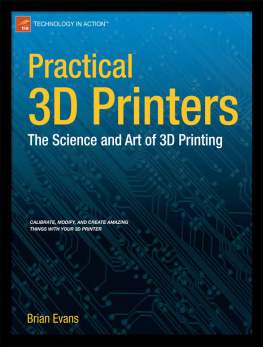
3D PRINTERS FOR WOODWORKERS
A SHORT INTRODUCTION
Henry Doolittle

3D Printers for Woodworkers
Copyright 2020 by Henry Doolittle.
All rights reserved. All images courtesy of the author unless otherwise noted.
All rights reserved. No part of this book may be reproduced or transmitted in any form or by any means, electronic or mechanical, including photocopying, recording, or by an information storage and retrieval system, without written permission from the publisher.
Published by Linden Publishing
2006 South Mary Street, Fresno, California 93721
(559) 233-6633 / (800) 345-4447
WoodworkersLibrary.com
Linden Publishing and Colophon are trademarks of Linden Publishing, Inc.
Book design by Andrea Reider
Cover design by Tanja Prokop, www.bookcoverworld.com
Linden Publishing titles may be purchased in quantity at special discounts for educational, business, or promotional use. To inquire about discount pricing, please refer to the contact information below. For permission to use any portion of this book for academic purposes, please contact the Copyright Clearance Center at www.copyright.com.
ISBN 978-1-933502-03-8
135798642
Printed in the United States of America
on acid-free paper.
Library of Congress Cataloging-in-Publication Data
Names: Doolittle, Henry, author.
Title: 3D printers for woodworkers : a short introduction / Henry Doolittle.
Description: Fresno, California : Linden Publishing, [2020] | Includes index.
Identifiers: LCCN 2020042551 | ISBN 9781933502038 (paperback) | ISBN 9781610353762 (epub)
Subjects: LCSH: Three-dimensional printing. | Woodwork--Equipment and supplies.
Classification: LCC TS171.95 .D66 2020 | DDC 621.9/88--dc23
LC record available at https://lccn.loc.gov/2020042551
Table of Contents
Foreword
3D Printers for Woodworkers offers a compressive look at the history, development, and usage of 3D printers. To understand a tool, it helps to understand its history: how it came about, how it was used, and how it evolved to its use today.
Once the history lesson is done, Henry Doolittle dives into the nitty-gritty of 3D printing. What types of printers are there? Which 3D printer is best for particular applications? What filaments do you need for your particular project? He answers all these questions along with discussing where to place your printer and how to calibrate the print head. Then Henry gives you projects to test your printers capabilities.
He shows successful prints and even more importantly shows you prints that go wrong. Then he explains in detail how to avoid the issue or fix it.
History and education are great, but a book on 3D printing had better share some useful and fun projects, and Henry does not disappoint. He provides well over a dozen projects for the woodworker. From a center finder to a pocket screw jig to a corner jig, Henry lays out the steps and tips needed to become a competent 3D craftsman.
If you want to test out this new technology, I highly recommend you purchase a copy of 3D Printers for Woodworkers as your introduction to the world of 3D printing.
Tim Yoder, nationally awarded television producer, photographer, editor, and longtime woodturner
Chapter 1
A History of 3D Printing
Major manufactures, such as Volkswagen and General Electric, have recently announced their intent to use 3D printers to mass produce parts.
George Takei, actor
A 3D printer built by Made In Space for use on the international Space Station. Made In Space
the authors demonstrated that the average household could save between $300 and $2,000 a year by printing items that they would normally purchase. In the study a college professor had his students look at the website Thingiverse and find items that homeowners would be buying on an annual basis at Home Depot. The cost savings were calculated based on the cost of the parts if purchased at Home Depot minus the cost to 3D print the same parts at home.
There are a number of websites offering 3D print files (known as STL files), including Thingiverse and MyMiniFactory. New print files are being generated daily, ranging from cosplay costumes to face shields for COVID-19. 3D printers are coming down in price and the quality of prints is increasing. Not long from now you will be able to go online at Home Depot or some similar website, pick out the tool or part needed, pay a nominal fee, download the print file for the part, and print it at home. In a couple of hours, you will have the part in hand, without leaving your shop.
The history of 3D printers is the history of computers. Without cheap computers 3D printers would never have come into existence. The two are inseparable. It takes a computer to generate the fine movements of a 3D printers print head. And to get 3D printing into the average home requires cheap computers. With faster, cheaper computers and controller boards, 3D printers will get better and easier to use.
The International Space Station (ISS) is about as far off the grid as you can get. When theres a problem, a quick run to the local hardware store isnt an option. If crew members dont have the tool they need, it is sent up on the next ship, which can be several months away. When they lose a tool, its lost. Its not like that 10 mm socket or tape measure you just dropped on the floor and bent over to pick up. When astronauts drop a tool, they have no choice but to watch it drift away. At some point in time it is going to drop back to Earth and end up in someones backyard.
NASA had a problem. How do you ensure that the ISS has the tools and parts needed to keep the station operational? In spite of its budget, the ISS does not have a tool room with an unlimited number of tools. The ISS can carry only so many 10-mm sockets. What size patches do you need? How many plumbing fittings do you take with you? Do you have the parts needed to fix the Wolowitz waste disposal system?
Having the parts on hand for every conceivable repair was not an option. They needed a method of producing necessary tools and parts when they needed them. They needed to be able to create and repair with the materials on the space station.
Enter 3D printing. Under contract with NASA, a company called Made In Space built a 3D printer for use in space. The printer was a FDM (fused deposition modeling) design made to work in a zero-gravity environment. In March of 2016, their 3D printer, called the AMF (additive manufacturing facility), was sent to the ISS. It has since printed over one hundred mission critical parts. NASA engineers have estimated that 30 percent of the parts in the ISS can be printed by a 3D printer. The only materials that need to be replenished for these printers are the rolls of filament.
The AMF is small, about the size of a toaster oven, with a build volume of 14 10 10 cm (5.5 4 4 inches). It is built to NASA standards, but it uses the same types of parts and works the same as all other FDM printers. And it uses the same filaments available for use with current hobby FDM printers. In fact, it is even possible to have a part printed on the ISS and have it delivered to Earth with the next space launch. Sure, the cost starts at $12,000, but you will have a part made in space! Made In Space is currently working on a 3D metal printer for use on future space missions.
Next page
